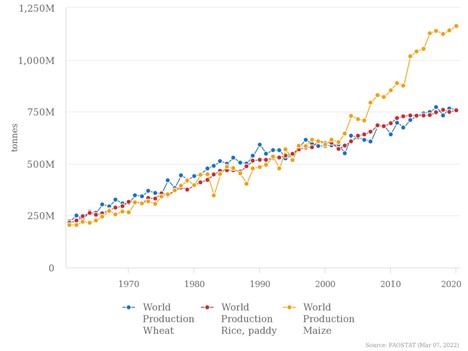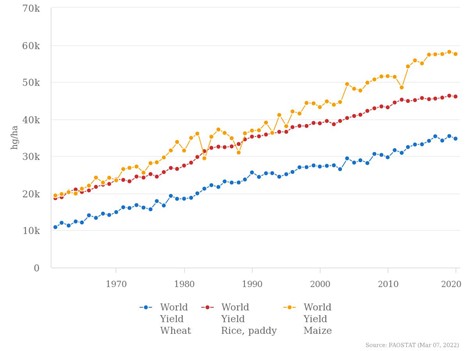The article, “Complex Models Now Gauge the Impact of Climate Change on Global Food Production. The Results Are ‘Alarming,’” says that there is a looming climate-caused global food crash that is projected to occur sooner than previously believed. The research depends entirely on agricultural projection models that depend upon the outputs of unreliable climate change models to make their projections.
The paper, “Climate impacts on global agriculture emerge earlier in new generation of climate and crop models,” presents the projections of a series of model runs comparing different crops around the globe based on the most recent Coupled Model Intercomparison Project (CMIP6) climate scenarios.
It uses two climate models, or representative concentration pathways (RCPs)—RCP2.60, and the discredited RCP8.5. These models have been shown to run too hot, projecting rising temperatures that are, in the words of the scientists who work on the models, “implausibly fast.”
As discussed in a Climate Realism post, here, two recent peer reviewed studies found a large degree of bias towards warmer projections, and that the CMIP5 models warm 4 to 5 times faster than actual observed temperature data. McKitrick and Christy (2020) write in “Persuasive warming bias in CMIP6 tropospheric layers” that “[W]e see no improvement between the CMIP5 and the CMIP6 models.”
If the current models used for temperature prediction are not accurate, then the food production models that rely on them cannot be expected to be accurate either.
The United Nations Intergovernmental Panel on Climate Change’s (IPCC) Sixth Assessment Report relied heavily on these same temperature models, particularly the implausible RCP8.5, and has been widely criticized by scientists for doing so. Climate Realism discussed the recent report here, and found that the report contained a large amount of speculation and very little evidence based on measured data.
The authors of the study assert that even the high mitigation scenarios, like RCP2.6, will still cause global food production to “soon face fundamentally changed risk profiles,” which will necessitate adaptation and “risk management” in global farming practices.
Data, however, show that major food crops have enjoyed rising global production over at least the last 60 years, alongside rising carbon dioxide and modest warming.
As originally discussed in this Climate Realism post, here, The United Nations Food and Agriculture Organization (FAO) has collected food production data from around the globe since 1961. For the staple crops, corn, wheat, and rice, this data shows significant rises in both overall production and yield per acre as the earth warms (see figures 1 and 2, below).


Corn, in particular, is discussed in the paper and cited by Inside Climate News as being threatened by global warming. However, during last few decades of warming, the FAO reports world corn production has risen by approximately 467 percent, and yields by more than 196 percent.
An analysis by Willis Eschenbach in a Climate Realism post here, broke down major food crops by country and average annual temperature, and found “the yields in the warmer countries are no better or worse than the yields in the cooler countries.”
This finding, along with the FAO data, suggests that the alarmism surrounding hotter temperatures and food production is unfounded.
As the popular saying in computer science goes: garbage in, garbage out. It is irresponsible and unethical to use unrealistic runaway warming scenarios to promote the idea that billions will starve from a climate change induced collapse of food production. This is especially true when one considers, as explored in more than 100 Climate Realism posts, real world data demonstrate higher carbon dioxide concentrations and the warmer planet are regularly producing record yields.



Excellent article! What most people don’t realize is that much of the heightened agricultural production, while driven by unrelenting population growth, has been enabled by a number of inputs and byproducts of fossil fuels. The CO2 produced from their combustion is, in and of itself, an important fertilizer, while petroleum and natural gas serve as the feedstock for the vast majority of our commercial fertilizers and pesticides. Furthermore, fossil fuels serve as the primary energy source for agricultural machinery (combines, tractors, driers, etc.), along with the transport of agricultural goods to markets. Fossil fuels have, in large part, spared us from the Hobbesian fate of life being “nasty, short, and brutish.”